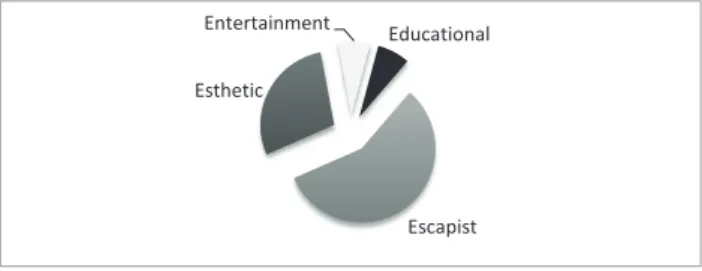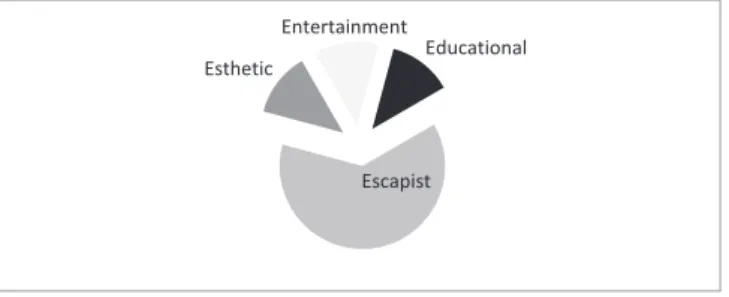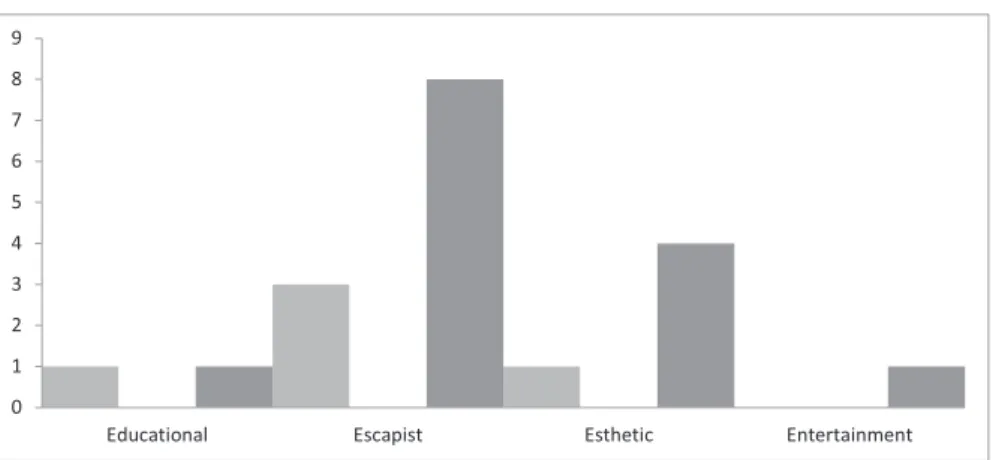Therefore, it is necessary to develop tourist villages in order to reduce the number of poor communities in rural areas. The existence of tourist villages in Indonesia is expected to increase the number of tourists visiting Indonesia and reduce rural poverty (Putra and Pitana, 2010).
Tourism villages in Bedulu Bali and Pentingsari Yogyakarta
One of the first tourist villages developed by the Indonesian government was the tourist village of Penglipuran, Bali, and subsequently expanded to other areas in Indonesia (Putra and Pitana, 2010). According to the Minister of Tourism and Creative Economy, Mari Elka Pangestu, the number of tourists visiting Indonesia in 2013 was 9.5 million and the target of the number of tourism villages in Indonesia in 2014 was 1561 villages and the target in 2020 will be 2,000 tourism villages.
CHAPTER II
- Community Participation in Community Based Tourism
- Sustainable Tourism Theory
- Tourism Village Concept as a Pro-Community Tourism Development Wacik (2010, cite in Putra and Pitana, 2010) states that, tourism has a major
- Economy Impact of Village Tourism
In the community-based tourism theory, tourist village is described as the implementation of ecotourism and requires the participation of local communities. Therefore, the tourist village and the variety of local community-based tourism activities with the environment and better services will achieve a positive economic impact on the local communities.
CHAPTER III
Quantitative Approach of Impact on Economy, Social and Environment of Bedulu Tourism Village
Sirubari Nepal Tourist Village also found that tourists are willing to pay double in the tourist village because the villagers preserve and protect the originality of the natural environment and provide optimal services. This statement is also supported by the study of Putra and Pitana (2010) on Candirejo tourist village in Central Java and some other tourist villages in Bali as a way to alleviate poverty. The quantitative approach of community-based tourism and their impact are analyzed by Agustini and Suarthana (2016) in research on community-based tourism in Kintamani.
Based on data collected from 52 respondents consisting of people who participated in the activities of the tourist village, the detailed description is as follows. The technique used to analyze the problem was the simple regression to calculate the impact of community participation in the social, cultural, economic and environmental aspects.
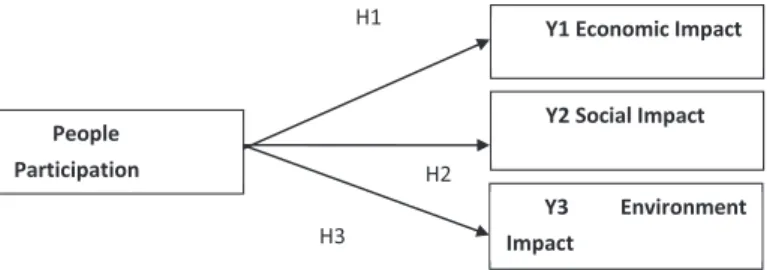
Impact of the Socio-Cultural Community Participation Model Summary b
- Quantitative Approach of Community Participation Aspect on Pentingsari Tourism Village
From the analysis of the three variables above, it results that public participation gives the greatest impact in economic terms, which amounts to 10.3%. The results of the evaluation of the measurement model against the indicators of this study are presented in table 1. The indicators that contribute the most to the Tourist Activities variable is the indicator of tourist activities that include all levels of society (X1.2), the load coefficient external. of 0.832; followed by the indicator of community-based tourism activities for the benefit of the community (X1.3) external load coefficient 0.773; the third is the indicator of community-based tourism activities varies (X1.1), external load coefficient 0.534.
The result shows that up to 29.2 percent of the economic impact of tourist activities have been affected. Hypothesis testing in this study will be done by testing the direct relationship between the economic impact variables of tourism activities.
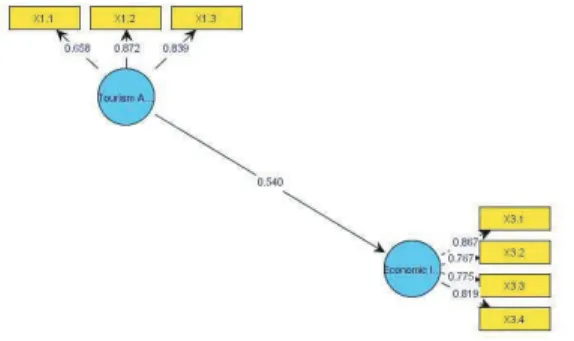
CHAPTER IV
Qualitative Approach of Bedulu and Pentingsari Tourism Villages and The Impact of Economy, Social and Environment
In this research, the determination of informants can be based on some considerations, therefore, the information obtained can be used as credible sources as follows. Village tourism management especially the manager of the tourist village because this person has experience in the village tourism management. The person is both physically and spiritually healthy, therefore he can give accurate information and think maturely.
The person is a native who owns a homestay, therefore he has experience in managing the visitors in the town tourism. Therefore, it is expected to obtain a conclusion about the problem learned based on the data collected in this research.
Level of Community Participation
Data were collected through observation, interview, documentation, FGD and other various secondary data which are close to the main questions studied, analyzed. Community participation in the management of the Pentingsari Pentingsari tourist village is very high, as evidenced by the results of the observation and interview of Mr. Sumardi, showing that 85 percent of the Pentingsari community supports and participates in the management of Pentingsari Village Tourism.
The indirect participation is done by those whose status is as civil servants and retirement by supporting cleanliness of the environment and maintaining security at night.
The impact of community participation against social and cultural life
The impact of community participation in preserving the environment It is the most critical aspect to make the environment still preserved
Management of the living environment is an integrated effort to maintain the function of the environment, including the expediency of protection, management, exploitation, development and control of the environment for the benefit of human life. The impact of community participation is to preserve the natural environment in Petingsari Village. Besides the fresh air, Pentingsari village also has a fresh and comfortable natural environment, which is very important to preserve. There are unwritten rules that the community sincerely followed, for example: when people want to cut down one big tree, the community must plant 10 trees before cutting down the tree, until the replacement plants are guaranteed to grow.
Environmental management was participative, including all comprehensive and connecting activities in creating harmonious relations between people and their environment. Environmental management is a comprehensive effort to protect, develop, regulate and control the environment for the well-being of human life.
T KH LPSDFW RI %HGXOXV¶ FRPPXQLW\ SDUWLFLSDWLRQ DV HFRQRPLF opportunities
Thus, the impact of Pentingsari tourism community and the surrounding areas gives additional income to the community for the welfare of family life, except for children school payment and the cost of daily life. Pentingsari village community feels the impact of the tourism to earn the family income, the reduction of unemployment and poverty in the village.
The Comparison of Bedulu And Petingsari Villages Tourism
Despite the differences in the market share, where Bedulu village tourism has more market share for the tourists and Petingsari tourism village has more market share for the householders and certainly the services and obstacles faced as a consequence of this distinction. Still, the differences and limitations provide stimulation for management to find solutions to strengthen the mechanism of management and services. Thus, although there are differences in trust and market segments, it also provides other differences from both tourist villages in terms of management, while essentially the management of village tourism between one and the other has several similarities.
Both village tourism, namely Bedulu village tourism and Petingsari village tourism involve local communities in their management, as village tourism is planned and shaped by community involvement, starting from planning, management and development; therefore, village tourism, which is actually from the community with the possessed potentials, will be managed by the community without involving investors and will have benefits for the society itself, either in the benefits of preserving the social culture, or the environment and economic benefits. as a result of village tourism development. Thus the economy of the local community will improve the standard of living and the well-being of the people is also increasing.
The Models of Village Tourism Activity in Bedulu and Pentingsari According to the FGD and in depth interview conducted with the key
Based on the qualitative approach, the interview and the FGD conducted with the key informants, the research results of the Pentingsari Village Tourism Model are described as shown in the figure below. Based on the above explanation and description, it can be concluded as follows. a) First, the level of public participation in Bedulu village tourism is high, as evidenced by the community involvement achieved 65. Bedulu village tourism is managed by the Dharmadoyana foundation, chaired by A.A. Ngurah Astawa, who coordinates and develops Bedulu village tourism by involving public participation to increase the preservation of the Bedulu community's social culture, environment and improving the economy.
The community supports the existence of rural tourism development, but the state of human resources is still poor. The government should devote more attention to the development of the rural tourism program in order to expand their role in reducing poverty.
Introduction of Experience Economy
Aspect of Experience Economy in Village Tourism in Bali Based on Paper: Widi Hardini and NLP Agustini Karta. The development of the tourist village creates value among stakeholders (especially for the local community) through economics and education. There is a large amount of research on Bali cultural tourism (especially in the tourist village) based on sustainability, community-based development, tourist satisfaction and marketing strategy.
Despite this, the approach to the experience economy concept with tourist villages has not yet been found. This research was conducted in three Bali tourist villages, Bedulu tourist village (Gianyar), Buahan tourist village (Bangli) and Taman Sari Buwana tourist village (Tabanan) based on the previous research (a continuous case study).
Concept of Tourism Village and Experience Economy
This research was conducted in three tourist villages in Bali, Bedulu Tourist Village (Gianyar), Buahan Tourist Village (Bangli) and Taman Sari Buwana Tourist Village (Tabanan) based on the previous research (an ongoing case study). 2014), the goal of the experience economy concept is to maximize the pursuit of customer satisfaction, to obtain economic benefits through the customer's deep personal experience. The mutual benefits between company and customer are achieved through the implementation of the experience economy concept. Defining the experience concept is done by elaborating the characteristic. 2007; quoted in Bille, 2010) elaborate the characteristic of experience as: (1) a high degree of concentration and focus; (2) the involvement of all senses;
In order to gain a deep understanding, Pine and Gilmore (1998) classified experience economy into four dimensions:. Qualitative analysis research method is used to carry out the dimensional experience economy concept in village tourism.
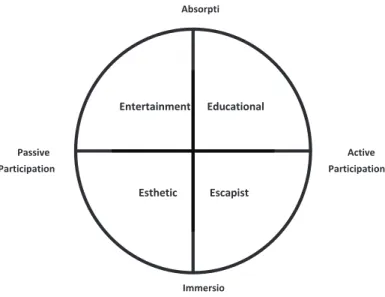
Implementation of Experience Economy in Tourism Village
The cultural tourism product or activities of Bedulu tourist village were GRPLQDWHGE\WKHDFWLYHVWRXULVW¶VSDUWLFLSDWLRQ(VFDSLVW and entertainment). However, the product of cultural tourism or Buahan tourist village activities DUHVWLOOGRPLQDWHGE\WKHDFWLYHVWRXULVW¶VSDUWLFLSDWLRQ(VFDSLWW. In this case of cultural tourism village, the results show that active participation activities are greater than passive participation activities.
This means that the memorable experience could be achieved by implementing the tourist village concept in the cultural tourism destination. Among the three tourist villages, Bedulu tourist village has the most product or activity variations, and Buahan tourism village has the fewest product or activity variations.
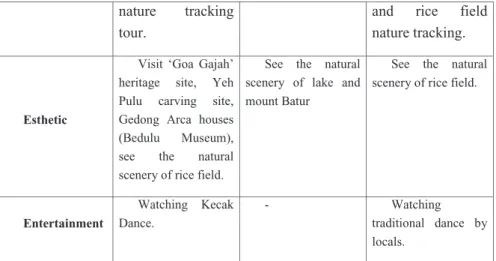
Conclusion
2001. Kɔƒenutowo me Tsaɖiɖi kple Ahedada le Bangladesh: Mɔnukpɔkpɔwo Ʋuʋu na Ame Dahewo, Curtin Mɔ̃ɖaŋununya Yunivɛsiti, WA, Curtin Tsaɖiɖi si Li Eteƒe Didi ƒe Dɔwɔƒe, Curtin Mɔ̃ɖaŋununya Yunivɛsiti,. ŚƌŝɛƚŽƵ͕͘;ϮϬϬϱͿ͘dŚŝÉŝÉĂĐŚĂ Ɖeɖe͘/Ŷ^ŝŐĂůĂ͕D͕͘>ĞÉůůŝĿ͕͕͕͕͕͕͕͕͠͠ ƌŶĂ ƚŝŽŶĂůƵůƚƵƌĂů dŽƵƌ ŝÉŵ͗DĂŶĂŐĞŵĞŶƚ͕/ŵÐeůŝĉƚƚŝŽŽŶ͕͕ DZͿ͘KĆĨ ŽƌĚ͗ůɛĞƀŝĞĞ ƵƚƚĞƌǁŽƌƚŚͲ,ĞŝŶĞŵĂŶ͘. ŽůĞ͕^͘;ϮϬϬςͿ͘dŚŝÉŝĂĐŚĂÐiƚĞƌ͘/Ŷ^ŵŵŝƚŚ͕D͘<͕͘ZŽďŝŝƌɛŽŶ͕ŝĂĐŚĂtɔɖeŋutɔ ͕D͘<͕͘ZŽďŝƚŚ͕D͘<͕͘ZŽďŝŝƌɛŽŶ͡ŝĂĐŚĂÐɔƚĞƌ͘; Ă ůdŽƵƌŝÉŵŝŶĂ ŚĂŶŐŝŐtŽƌůĚ͗WŽůŝƚŝĐɛ͕WĂƌƚŝĐŝĐŝĐĐɛ͕WĂƌƚŝĐŝĐŝĐŝĂƚŚĚĚĐŝĐŝĂŝĂƚŚĚĚĐŝĐŝĂƚĂƚŶŐŐŝŐtŽƚůĚĚĚĚĚĚ ŽůŝƚŝĐɛ͕WĂÐƚŝĐŝƞƚŚĚĐŝ ĂŝƞƚŚŝŝŶĂŝ ŽŶ͡Míeɖe asi le eŋu ĞůsŝĞǁ WƵďůŝĐĂƚŝŽŶɛ͘.
ŶƚĞƌŶĂƚŝŽŶĂů:ŽƵƌŶĂůŽĨƵÈŝŶĞĂŶĚ^ŽĐŝĂů^ĐŝĞŶĐĞ͕ϱ; ŶĞƚ͘ĐŽŵͬũŽƵƌŶĂůͬsŽůͺҺıĺEŽĵČƺͺ^ÐeĞĐ͝ ͺϬ ϭϰͬϳ ͘ÐĚĨ. DĂĚŝƵŶ͕/͘E͘ϮϬϬϴ͘WĂƌƚŝÉŝĂĂĂÉŝDĂÉLJĂƌĂŬĂƚ>ŽŽŬĂůĂůĂůĂŵWĞŶŶŝÉŝĂÉ ŽŬĂůĂůĂŵWĞŶŝĂŞŝ WĂƌŝǁŝɛĂƚĂ EƵɛĂƵĂ; ƚĂɛ hĚĂLJĂŶĂ͕ĞŶÐeĂɛĂƌ͘. EĞƉĂů͕͘<͘ϮϬϬϳ͘/ŶĚŝŐĞŶŽƵÈWĞƌɛÐeĞĐƚŝǀĞÉŽŶĐŽƚŽĵĵƌŝÉŵŝŶĞƌɛɖeĞĞĐƚŝĞĞÉŽŽĐŽ ŽĵĉƌŝÉŵŝŶŶĞƌ Ă ƌŬĂͲ^ŝŬůĞE ĂŶĚ^ŝƌƵĂƌŝdžÐÞƌŝĞŶĐĞ͘/ŶŝĂŶĐĞ͘/ŶŝĂŵ͕:͘; ŝĞŶĐĞ͘/Ŷ͗,ŝŐŚĂŵ͕:͘;ĚͿŗŐɌŝƚ ŽƚŽƵ ƌŝÈŵ͗. 2007. Dukɔmeviwo ƒe Nukpɔsusuwo le Nutoa Me Tsaɖiɖi ŋu le Nepal: Ghale Kharka-Drapari kple Sirubari ƒe Nuteƒekpɔkpɔ.
ĂÉƚƌĂLJƵĚĂ͕'ƵŵĞůĂƌ^͘ϮϬϭϬ͘<ŽŶɛĞƉƉĞŶŐĞŵďĂŶŐĂŶŬĂǁĂɛĂŶĚŬĂǁĂɛŝĂŶĚĞɛĂ ǘŶĚĞɛĂ ǘŚŚĞɛĂ ǘŚǁɛĂ ǘŚǁɛĂ . 1999) Sastrayuda, Gumelar S. (1999).
